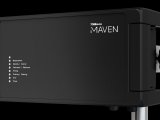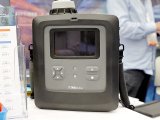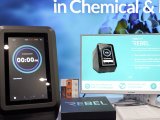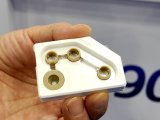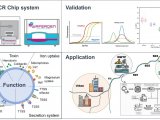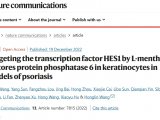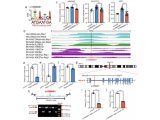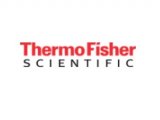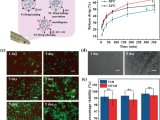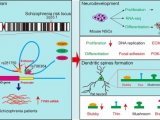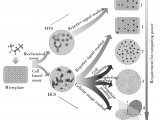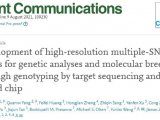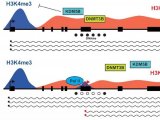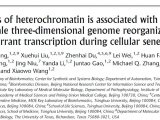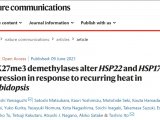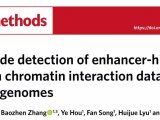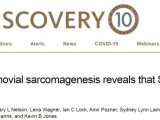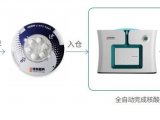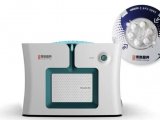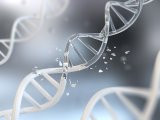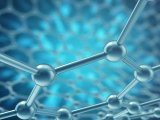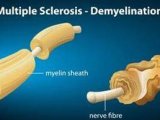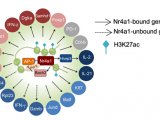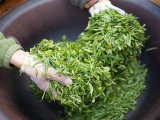实验概要
The immunoprecipitation (IP) of cross-linked chromatin with antibodies specific for certain histone modifications (chromatin immunoprecipitation, ChIP), followed by PCR to detect a potential enrichment or depletion of a DNA sequence of interest within IP fractions, constitutes an elegant and direct method to query specific chromatin states of individual genes.
实验原理
Eukaryotic chromatin is a complex of DNA and associated histone proteins that are involved in the higher order packaging of DNA into chromosomes. The chromatin state of a given DNA sequence influences transcriptional activity and replication timing and is regulated by potentially reversible covalent modifications of DNA and histones. Histone modifications at conserved lysine and arginine residues within the flexible N-terminal tails, such as phosphorylation, acetylation and methylation, specify a code that serves as an interaction platform with specific domains of chromatin-associated proteins. The immunoprecipitation (IP) of cross-linked chromatin with antibodies specific for certain histone modifications (chromatin immunoprecipitation, ChIP), followed by PCR to detect a potential enrichment or depletion of a DNA sequence of interest within IP fractions, constitutes an elegant and direct method to query specific chromatin states of individual genes and is already routinely used in many labs. In contrast to animal cells, however, plant cells have a rigid cell wall which poses limitations to the simple utilization of protocols established for animals. In this protocol, the method described in used to study histone modifications in the plant model organism Arabidopsis thaliana. This protocol is an adapted version of the original procedure published by Lawrence and co-workers.
This protocol describes how chromatin is prepared from Arabidopsis, which can subsequently be used for chromatin immunoprecipitation (ChIP). The exact chromatin concentration should be determined before starting the X-ChIP assay.
主要试剂
Extraction buffer 1
0.4 M Sucrose
10 mM Tris-HCl, pH 8.0
10 mM MgCl2
5 mM β-mercaptoethanol
Protease inhibitors
Extraction buffer 2
0.25 M Sucrose
10 mM Tris-HCl, pH 8.0
10 mM MgCl2
1% w/v Triton X-100
5 mM β-mercaptoethanol
Protease inhibitors
Extraction buffer 3
1.7 M Sucrose
10 mM Tris-HCl, pH 8.0
2 mM MgCl2
0.15% w/v Triton X-100
5 mM β-mercaptoethanol
Protease inhibitors
Nuclei lysis buffer
50 mM Tris-HCl, pH 8.0
10 mM EDTA
1% w/v SDS
Protease inhibitors
Protease inhibitor
100 mM PMSF
One tablet per 10ml of solution of complete mini protease inhibitor cocktail tablets (Roche®)
FA Lysis Buffer
50 mM HEPES-KOH pH7.5
140 mM NaCl
1 mM EDTA pH8
1% Triton X-100
0.1% Sodium Deoxycholate
0.1% SDS
Protease Inhibitors (add fresh each time)
RIPA Buffer
50 mM Tris-HCl pH8
150 mM NaCl
2 mM EDTA pH8 1% NP-40
0.5% Sodium Deoxycholate
0.1% SDS
Protease Inhibitors (add fresh each time)
Wash Buffer
0.1% SDS
1% Triton X-100
2 mM EDTA pH8
150 mM NaCl
20 mM Tris-HCl pH8
Final Wash Buffer
0.1% SDS
1% Triton X-100
2 mM EDTA pH8
500 mM NaCl
20 mM Tris-HCl pH8
Elution Buffer
1% SDS
100mM NaHCO3
实验材料
Arabidopsis seeds are stratified for 48 hours in 0.1% Phytablend w/v at 4°C and then sown onto soil. 1.5 g of whole, three to four week-old seedlings, are used per chromatin preparation. It is imperative to avoid contamination with soil as much as possible during harvest.
实验步骤
1. Chromatin cross-linking
1) Harvest 1.5 g seedlings and place them into a 50 ml tube.
2) Rinse seedlings twice with 40 ml double distilled water. Remove as much water as possible after second wash.
3) Add 37 ml 1% w/v formaldehyde solution. Gently submerge seedlings at the bottom of the tube by stuffing the tube with nylon mesh. Screw on cap and poke cap with needle holes. Put in exsiccator and draw vacuum for ten minutes.
4) Release vacuum slowly and shake exsiccator slightly to remove air bubbles. Seedlings should appear translucent.
5) Add 2.5 ml 2 M glycine to quench cross-linking. Draw vacuum for five minutes.
6) Again, release vacuum slowly and shake exsiccator slightly to remove air bubbles.
7) Remove nylon mesh, decant supernatant and wash seedlings twice with 40 ml of double distilled water. After second wash, remove as much water as possible and put seedlings between two layers of kitchen paper. Roll up paper layers carefully to remove as much liquid as possible.
At this step, plant material can be snap-frozen in liquid nitrogen and stored at -80°C
2. Chromatin preparation
1) Pre-cool mortar with liquid nitrogen. Add two small spoons of white quartz sand (Sigma Cat.: 27,473-9) and plant material. Grind plant material to a fine powder.
2) Use cooled spoon to add powder to 30 ml of extraction buffer 1 stored on ice. Vortex to mix and keep at 4°C until solution is homogenous.
3) Incubate for 30 min at 4°C with gentle agitation.
4) Filter extract through into a new, ice-cold 50 ml conical tube. Press to recover extract from solid material.
5) Repeat step four.
6) Centrifuge extract at 4000 rpm for 20 minutes at 4°C.
7) Gently pour off supernatant and resuspend pellet in 1 ml of extraction buffer 2 by pipetting up and down. Transfer solution to Eppendorf tube.
8) Spin in cooled benchtop centrifuge at 13000 rpm for ten minutes.
9) Remove supernatant and resuspend pellet in 300 µl of extraction buffer 2 by pipetting up and down.
10) Add 300 µl of extraction buffer 3 to fresh Eppendorf tube. Use pipette to carefully layer solution from step nine onto it.
11) Spin in cooled benchtop centrifuge at 13000 rpm for one hour. In meantime, prepare 10 ml nuclei lysis buffer. Put buffers in coldroom.
12) Remove supernatant and resuspend pellet in 300 to 500 µl of cold nuclei lysis buffer. Resuspend by pipetting up and down and by vortexing. Keep solution cold between vortexing. Incubate for 20 minutes on ice.
13) Remove 10 µl to run on an agarose gel.
14) Sonicate for ten minutes at 4°C.
15) Spin in cooled benchtop centrifuge at 13000 rpm for ten minutes. Add supernatant to new Eppendorf tube.
16) Repeat step 14. Remove 10 µl to run on an agarose gel
17) Separate aliquots from steps 12 and 15 on 1.5% w/v agarose gel. In the sonicated samples, DNA should be shifted and more intense compared to untreated samples and range between 200-2000 bp, centering around 500 bp.
3. Cross-linking and cell harvesting
Formaldehyde is used to cross-link the proteins to the DNA. Cross-linking is a time dependent procedure and optimization will be required. We would suggest cross-linking the samples for 2 - 30 min. Excessive cross-linking reduces antigen accessibility and sonication efficiency. Epitopes may also be masked. Glycine is added to quench the formaldehyde and terminates the cross-linking reaction.
1) Start with two confluent 150 cm2 dishes (1x107- 5x107 cells per dish). Cross-link proteins to DNA by adding formaldehyde drop-wise directly to the media to a final concentration of 0.75% and rotate gently at room temperature (RT) for 10 min.
2) Add glycine to a final concentration of 125 mM to the media and incubate with shaking for 5 min at RT.
3) Rinse cells two times with 10 ml cold PBS.
4) Scrape cells into 5 ml cold PBS and transfer into 50 ml tube.
5) Add 3 ml PBS to dishes and transfer the remainder of the cells to the 50 ml tube.
6) Centrifuge for 5 min, 1,000 g.
7) Carefully aspirate off supernatant and resuspend pellet in FA Lysis Buffer (750 μl per 1x107 cells).
When using suspension cells, start with 1x107- 5x107 cells and treat with both 0.75% formaldehyde and glycine as described above (Section 1). Pellet cells by centrifugation (5 mins,1,000 g). Wash 3 times with cold PBS and resuspend pellet in FA Lysis Buffer (750 μl per 1x107 cells). Proceed to Step 2.1.
4. Sonication
1) Sonicate lysate to shear DNA to an average fragment size of 500 - 1000 bp. This will need optimizing as different cell lines require different sonication times.
The cross-linked lysate should be sonicated over a time-course to identify optimal conditions. Samples should be removed over the time-course and DNA isolated as described in Section 3. The fragment size should be analyzed on a 1.5% agarose gel as demonstrated in Figure 1.
2) After sonication, pellet cell debris by centrifugation 30 sec, 4°C, 8,000 g. Transfer supernatant to a new tube. This chromatin preparation will be used for the immunoprecipitation (IP) in Step 4.
3) Remove 50 μl of each sonicated sample, this sample is the INPUT. This is used to quantify the DNA concentration (see Step 3) and as a control in the PCR.
The sonicated chromatin can be snap frozen in liquid nitrogen and stored at -70°C for up to 2 months. Avoid multiple freeze-thawing.
5. Determination of DNA concentration
1) The INPUT samples are used to calculate the DNA concentration for subsequent IPs. The DNA is purified using either a PCR purification kit (add 70 μl of Elution Buffer and proceed to Step 3.2a) or phenol:chloroform (add 350 μl of Elution Buffer and proceed to Step 3.2b).
2) a. Add 2 μl RNase A (0.5 mg/ml). Heat with shaking at 65°C for 4-5 hr (or overnight) to reverse the cross-links. DNA is purified using a PCR purification kit according to the manufacturer’s instructions. The samples can be frozen and stored at -20°C.
Samples are treated with RNase A as high levels of RNA will interfere with DNA purification when using the PCR purification kit. Yields can be severely reduced as the columns become saturated.
3) b. Add 5 ul proteinase K (20 mg/ml). Heat with shaking at 65°C for 4-5 hr (or overnight) to reverse the cross-links. The DNA is phenol:chloroform extracted and ethanol precipitated in the presence of 10 μl glycogen (5 mg/ml). Resuspend in 100 μl H2O. The samples can be frozen and stored at -20°C.
Samples are treated with proteinase K, which cleaves peptide bonds adjacent to the carboxylic group of aliphatic and aromatic amino acids. Cross-links between proteins and DNA are disrupted which aids DNA purification.
4) To determine the DNA concentration, transfer 5 μl of the purified DNA into a tube containing 995 μl TE to give a 200-fold dilution and read the OD260. The concentration of DNA in μg/ml is OD260 x 10,000. This is used to calculate the DNA concentration of the chromatin preparation.
6. Immunoprecipitation
1) Use the chromatin preparation from Step 2.2, an equivalent amount of approximately 25 μg of DNA per IP is recommended. Dilute each sample 1:10 with RIPA Buffer. You will need one sample for the beads-only control.
2) Add primary antibody to all samples except the beads-only control. The amount of antibody to be added should be determined empirically; 1-10 μg of antibody per 25 μg of DNA often works well.
3) Add 20 μl of protein A/G beads (pre-adsorbed with sonicated single stranded herring sperm DNA and BSA, see step 4.3a) to all samples and IP overnight with rotation at 4°C.
4) a. Preparation of protein A/G beads with single stranded herring sperm DNA. If using both Protein A and Protein G beads, mix an equal volume of Protein A and Protein G beads and wash three times in RIPA Buffer. Aspirate RIPA Buffer and add single stranded herring sperm DNA to a final concentration of 75 ng/μl beads and BSA to a final concentration of 0.1 μg/μl beads. Add RIPA Buffer to twice the bead volume and incubate for 30 min with rotation at RT. Wash once with RIPA Buffer and add RIPA Buffer to twice the bead volume.
Protein A beads, protein G beads or a mix of both should be used. Table 1 shows the affinity of protein A and G beads to different Immunoglobulin isotypes.
5) Centrifuge the protein A/G beads for 1 min, 2,000 g and remove the supernatant.
6) Wash beads three times with 1 ml Wash Buffer. Centrifuge 1 min, 2,000 g and remove the supernatant.
7) Wash beads one time with 1 ml Final Wash Buffer. Centrifuge 1 min, 2,000 g and remove the supernatant.
If high background is observed additional washes may be needed. Alternatively, the sonicated chromatin may also be pre-cleared by incubating with the Protein A/G beads for 1 hr prior to Step 4.2. Any non-specific binding to the beads will be removed during this additional step. Transfer the supernatant (sonicated chromatin) to a new tube and incubate with the antibody and beads as described in Step 4.2 onwards.
7. Elution and reverse cross-links
1) Elute DNA by adding 120 μl of Elution Buffer to the protein A/G beads and rotate for 15 min, 30°C.
2) Centrifuge for 1 min, 2,000 g and transfer the supernatant into a fresh tube. The samples can be stored at -20°C
3) The DNA can be purified using a PCR purification kit (proceed with Step 3.2a) or phenol:chloroform (add 280 μl of Elution Buffer and proceed with Step 3.2b).
4) DNA levels are quantitatively measured by real-time PCR. Primers and probes are often designed using software provided with the real-time PCR apparatus.
